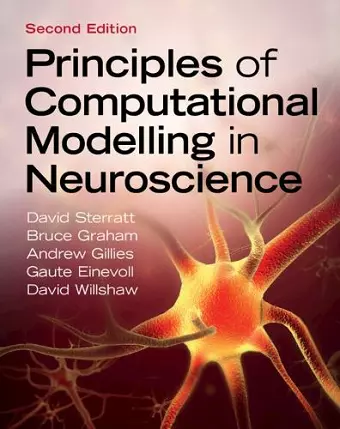Principles of Computational Modelling in Neuroscience
Bruce Graham author Andrew Gillies author David Sterratt author David Willshaw author Gaute Einevoll author
Format:Hardback
Publisher:Cambridge University Press
Published:5th Oct '23
£125.00
Supplier delay - available to order, but may take longer than usual.
This hardback is available in another edition too:
- Paperback£54.99(9781108716420)

Learn to use computational modelling techniques to understand the nervous system at all levels, from ion channels to networks.
Providing a step-by-step and practical account of how to model neurons and neural circuitry, this textbook is designed for advanced undergraduate and postgraduate students of computational neuroscience as well as for researchers in neuroscience and related sciences wishing to apply computational approaches to interpret data and make predictions.Taking a step-by-step approach to modelling neurons and neural circuitry, this textbook teaches students how to use computational techniques to understand the nervous system at all levels, using case studies throughout to illustrate fundamental principles. Starting with a simple model of a neuron, the authors gradually introduce neuronal morphology, synapses, ion channels and intracellular signalling. This fully updated new edition contains additional examples and case studies on specific modelling techniques, suggestions on different ways to use this book, and new chapters covering plasticity, modelling extracellular influences on brain circuits, modelling experimental measurement processes, and choosing appropriate model structures and their parameters. The online resources offer exercises and simulation code that recreate many of the book's figures, allowing students to practice as they learn. Requiring an elementary background in neuroscience and high-school mathematics, this is an ideal resource for a course on computational neuroscience.
'This new edition builds superbly on its predecessor. Expository excellence and beautifully clear figures remain, whilst extra material has been added throughout. New chapters cover critical topics such as modelling the way that neural signals are measured, and the details of model optimization and selection. Its impressive combination of depth and breadth makes the text perfect source material for a wide variety of courses.' Peter Dayan, Managing Director, Max-Planck Institute for Biological Cybernetics, Tuebingen
'Principles of Computational Modelling in Neuroscience has long been my choice for my students from various backgrounds, but now it is even better! With the addition of comprehensive coverage for modelling extracellular activity, neural plasticity, and experimental stimulation and measurements, this text offers everything that my students need for a foundation in computational neuroscience. The new chapter on Model Section and Optimisation makes a difficult topic easy to understand. Principles of Computational Modelling in Neuroscience remains the best choice of a text that is rigorous but accessible to students from a variety of backgrounds.' Sharon Crook, Arizona State University
'I am thrilled to endorse the second edition of Principles of Computational Modelling in Neuroscience. This comprehensive and well-written text is an engaging resource on the fundamentals of biophysical modelling and computational neuroscience. The range of topics and clarity of exposition provides a spectacular display of the power of computational techniques to provide insight into the mysteries of central nervous system function across its diverse hierarchical levels. This second edition contains many additional examples and new chapters on synaptic plasticity and learning, modelling of experimental measurements, as well as model selection and optimization. The authors have a remarkable ability to explain complex concepts in a clear and accessible manner, making this book an ideal choice for both students and researchers. The gradually increasing sophistication of each chapter makes it highly suited as a textbook for an introductory undergraduate course focusing on computational aspects of cell and systems neuroscience.' Greg Conradi Smith, William & Mary, Virginia and author of Cellular Biophysics and Modeling (Cambridge, 2019)
'A valuable resource for both students and practitioners of computational modelling in neuroscience. The authors provide a step-by-step guide to modelling, from simple neurons to complex brain tissue. Each model is carefully explained and illustrated, put into context and critiqued. A definitive text for anyone wanting to develop their own models of neural circuitry!' Rosemary Fricker, Keele University Medical School; and Wolfson College, University of Cambridge
'This textbook is useful for engineers, mathematicians, biologists and computer scientists. It provides a deep understanding of neuron computational modelling. The approach used, from ion channels to the new plasticity chapter, provides the student with a full picture of neural network behaviour. Furthermore, this new edition includes some cases of studies where the concepts are applied to real experimental data.' Fernando Perez-Peña, University of Cadiz
'We have been using the book by Sterratt et al. for many years on our courses in theoretical neuroscience, to teach the basics of biophysics. The book does an excellent job of providing the basics in a highly understandable way for beginners in the field with lots of practical examples and additional background material for the implementation of models. The new edition of the book is even more useful since it integrates a lot of new material: nonlinear dynamics and bifurcations, neural field models, the modelling of measurement methods, and optimization. In addition, programming examples have been added, making the book even more useful for teaching.' Martin Giese, University of Tuebingen
'This book is an invaluable resource for computational neuroscientists, particularly for students starting their doctoral research. The comprehensive coverage, clear prose and extensive examples make it easy for a newcomer with only basic background knowledge to get to grips with a wide variety of complex computational modelling topics as a preparation for starting their own investigations.' Abigail Morrison, RWTH Aachen University
ISBN: 9781108483148
Dimensions: 262mm x 210mm x 35mm
Weight: 1350g
544 pages
2nd Revised edition